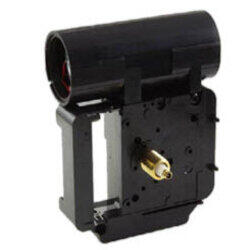
Clock Parts
Senior Analyst, Parascientific Solutions
New Electronic Clock Movements
Clock movements are the engines, or electric motors, that control the turning as well as positioning of the hands for proper time telling. Clock movements were traditionally mechanical and also analog, yet in modern times they are almost solely electronic, and also either analog or digital. Regardless, the function needed boils down to the dimension of the angle subtended by each hand at every moment.
Clock movements are frequently described as electric motors, and the terms are virtually compatible. The force behind a mechanical one was either a coiled spring or a hanging weight creating a flywheel to turn. To avoid "freewheeling," or runaway turning, pendulums and escapement mechanisms were utilized, developing an oscillation that had a particularly obtained regularity.
The contemporary electronic motion obtains its power from a quartz crystal shaking at a particular regularity that represents the geometry of the crystal. With a voltage decline applied to the crystal, it sends out a series of pulses at the powerful frequency. Gathering the number of pulses right into an electronic register keeps an eye on the quantity of lapsed time.
This running overall of pulses is a high multiple of the seconds and minutes needed for telling time, so software application subdivides the number down to something valuable. The mechanical analog of this procedure is achieved making use of a network of gears in specific ratios. In both the electronic as well as mechanical technique, the advancement of every second triggers the pre-owned to subtend one more 6 degrees of arc.
An additional register collects seconds into minutes, as well as a third matters minutes right into hours. When the matching threshold is crossed, the loved one hand is progressed an additional tick. Ultimately, each register obtains reset back to no, establishing an overall cycle when every little thing begins again once more.
This "ultimately" commonly implies 12 hours, however there's no factor it can not be expanded well past that. It's pretty much say goodbye to complex than setting a specification in the movement software program. So, it's easy to increase the cycle to 24 hours (which would need a various dial), but readily offered are motors that go out a week and even a month.
These last 2 extensions require an added hand to point to the day of the week or the date in the month, specifically. Yet a various kind of extension uses a cycle of 24-hour and also 50 mins, which represents the period of the lunar transformation around the earth. Therefore, it can be utilized to show the present degree of the tide (if adjusted to your area of the sea).
There are also movements for showing climate phenomena, such as temperature or humidity. Unlike the trend level, which is a regular reappearance like time, such sensations differ within a particular range, as well as the worths need to be digitized from sensing unit input. The equivalent dial is calibrated so that the hand turns through less than one cycle.
Note that digital clock movements are capable of a lot greater than their mechanical equivalents because of the software program facet. The physical positioning of the hand or hands is the same for both, yet the derivation of placement is an order of magnitude much more complicated for the mechanical version.
Movements show attribute sets, and also some features we have not also defined. Remember that conventional electric motors are created for clocks less than 12-14 inches in diameter, as their torque limitation can't revolve longer minute hands. It is possible to develop bigger clocks (equalize to 6 feet throughout!), but you need to purchase the high-torque version of the activity the feature set of which you wish to implement.
A lot of electric motors work on batteries (typically AA or C), though other power choices are often offered. You can additionally discover novelties such as pendulums or chimes. There is no end to the satisfaction one can derive from modern-day electronic clock movements.
clock movements